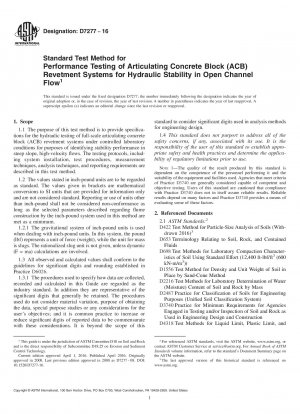ASTM D7277-16
Standard Test Method for Performance Testing of Articulating Concrete Block (ACB) Revetment Systems for Hydraulic Stability in Open Channel Flow
- Standard No.
- ASTM D7277-16
- Release Date
- 2016
- Published By
- American Society for Testing and Materials (ASTM)
- Status
- Replace By
- ASTM D7277-16(2023)
- Latest
- ASTM D7277-16(2023)
- Scope
5.1 An articulating concrete block revetment system is comprised of a matrix of individual concrete blocks placed together to form an erosion-resistant revetment with specific hydraulic performance characteristics. The system includes a filter layer compatible with the subsoil which allows infiltration and exfiltration to occur while providing particle retention. The filter layer may be comprised of a geotextile, properly graded granular media, or both. The concrete blocks within the matrix shall be dense and durable, and the matrix shall be flexible and porous.
5.2 ACB revetment system are used to provide erosion protection to underlying soil materials from the forces of flowing water. The term “articulating,” as used in this standard, implies the ability of individual concrete blocks of the system to conform to changes in subgrade while remaining interconnected by virtue of geometric interlock, cables, ropes, geotextiles, geogrids, or combination thereof.
5.3 The definition of ACB revetment system does not distinguish between interlocking and non-interlocking block geometries, between cable-tied and non-cable-tied systems, between vegetated and non-vegetated systems or between methods of manufacturing or placement. Furthermore, the definition does not restrict or limit the block size, shape, strength, or longevity; however, guidelines and recommendations regarding these factors are incorporated into this standard. Blocks are available in either open-cell or closed-cell configurations.
1.1 The purpose of this test method is to provide specifications for the hydraulic testing of full-scale articulating concrete block (ACB) revetment systems under controlled laboratory conditions for purposes of identifying stability performance in steep slope, high-velocity flows. The testing protocols, including system installation, test procedures, measurement techniques, analysis techniques, and reporting requirements are described in this test method.
1.2 The values stated in inch-pound units are to be regarded as standard. The values given in brackets are mathematical conversions to SI units that are provided for information only and are not considered standard. Reporting or use of units other than inch-pound shall not be considered non-conformance as long as the selected parameters described regarding flume construction by the inch-pound system used in this method are met as a minimum.
1.2.1 The gravitational system of inch-pound units is used when dealing with inch-pound units. In this system, the pound (lbf) represents a unit of force (weight), while the unit for mass is slugs. The rationalized slug unit is not given, unless dynamic (F = ma) calculations are involved.
1.3 All observed and calculated values shall conform to the guidelines for significant digits and rounding established in Practice D6026.
1.3.1 The procedures used to specify how data are collected, recorded and calculated in this Guide are regarded as the industry standard. In addition they are representative of the significant digits that generally be retained. The procedures used do not consider material variation, purpose of ob......
ASTM D7277-16 Referenced Document
- ASTM D1556 Standard Test Method for Density and Unit Weight of Soil in Place by the Sand-Cone Method
- ASTM D2216 Standard Test Method for Laboratory Determination of Water (Moisture) Content of Soil and Rock by Mass
- ASTM D2487 Standard Test Method for Classification Of Soils For Engineering Purposes
- ASTM D3740 Standard Practice for Minimum Requirements for Agencies Engaged in the Testing and/or Inspection of Soil and Rock as Used in Engineering Design and Construction
- ASTM D422 Standard Test Method for Particle-Size Analysis of Soils
- ASTM D4318 Standard Test Methods for Liquid Limit, Plastic Limit, and Plasticity Index of Soils
- ASTM D5195 Standard Test Method for Density of Soil and Rock In-Place at Depths Below the Surface by Nuclear Methods
- ASTM D6026 Standard Practice for Using Significant Digits in Geotechnical Data
- ASTM D653 Standard Terminology Relating to Soil, Rock, and Contained Fluids
- ASTM D698 Standard Test Methods for Laboratory Compaction Characteristics of Soil Using Standard Effort (12 400 ft-lbf/ft3 (600 kN-m/m3))
ASTM D7277-16 history
- 2023 ASTM D7277-16(2023) Standard Test Method for Performance Testing of Articulating Concrete Block (ACB) Revetment Systems for Hydraulic Stability in Open Channel Flow
- 2016 ASTM D7277-16 Standard Test Method for Performance Testing of Articulating Concrete Block (ACB) Revetment Systems for Hydraulic Stability in Open Channel Flow
- 2008 ASTM D7277-08 Standard Test Method for Performance Testing of Articulating Concrete Block (ACB) Revetment Systems for Hydraulic Stability in Open Channel Flow

Copyright ©2024 All Rights Reserved